Imagine you set up an incredible party for your friends and family, complete with delicious food and first-rate entertainment. However, you never send invitations or inform anyone about the event details, so no one shows up on the big day.
This sounds like a total waste of a great party, right?
Similar to hosting a successful party, running a successful nonprofit requires you to get the word out about your organization and get others involved. That’s where marketing comes into play.
Depending on the size of your nonprofit and how long your operations have been up and running, you may or may not have a solid nonprofit marketing plan. To ensure you’re equipped to raise awareness for your cause, encourage support, and let the community know about your services and programs, we’ve created this guide to help you get started or improve your strategy. We’ll cover:
- Nonprofit Marketing: Essential Background Info
- 7 Steps to Create Your Own Nonprofit Marketing Plan
- Our FREE Nonprofit Marketing Plan Template
- The Role of Your Website in Your Marketing Plan
At Cornershop Creative, we understand the importance of harnessing the power of marketing to do more for those you serve, especially online. This guide compiles our top guidance from years of working with nonprofits to level up their outreach. As you begin designing or revamping your own marketing strategy, don’t be afraid to turn to experts for guidance. Let’s begin!
A well-designed website is the foundation of a great nonprofit marketing plan. Work with Cornershop Creative to design your own!
Nonprofit Marketing: Essential Background Info
What is Nonprofit Marketing?
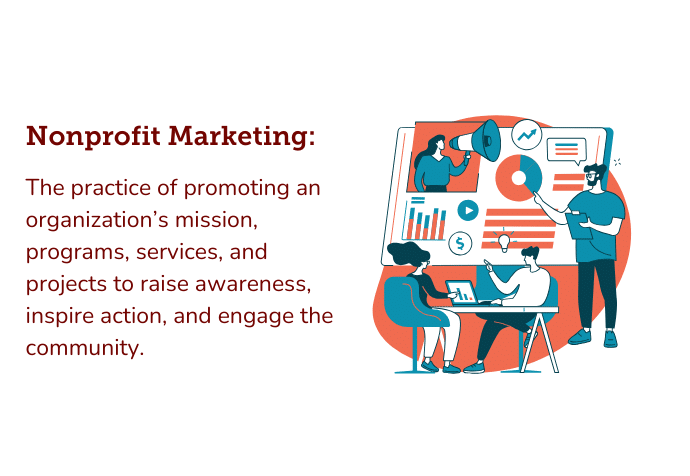
Nonprofit marketing is the practice of promoting an organization’s mission, programs, services, and projects to raise awareness, inspire action, and engage the community. It typically involves creating content to distribute through various channels (e.g., a website, social media profiles, email newsletters, and more).
For-profit organizations also engage in marketing, but mainly to make a profit by selling goods or services. For nonprofits, marketing is more focused on building strong relationships with supporters, encouraging donations (and other forms of support, such as volunteering), and spreading the word about programs and services available to beneficiaries.
There is no one-size-fits-all approach to marketing. Your nonprofit will need to develop a marketing plan that is unique to its goals, incorporates engaging messaging, and covers both online and offline channels with which you can reach your community.
Why Nonprofit Marketing is Important
Marketing can benefit your organization in several ways. In particular, it can help you:
- Raise awareness of your mission
- Drive actions like donating, volunteering, and more
- Connect with beneficiaries who need your programs and services
- Have consistent touchpoints with current supporters
- Boost your organization’s visibility
- Strengthen trust and credibility with the community
- Advance advocacy objectives
- Pave the way for successful partnerships with fellow nonprofits, for-profit sponsors, and other community partners
Though a successful nonprofit marketing approach requires an investment of time and money to get right (not to mention some trial and error), the results will be well worth the effort. Take the time to develop a deliberate strategy now that you can fine-tune down the line as you become more experienced in careful outreach.
Understanding the Marketing Funnel
To better understand the purpose of nonprofit marketing, it may be helpful for your team to picture the marketing process as guiding your supporters through a funnel. This visualization can help you see what it takes to get someone from not knowing about your organization to being a loyal, lifelong supporter of your cause.
Here are the general stages each supporter needs to be guided through with your marketing work:

- Awareness: Potential supporters first learn about your nonprofit and its mission. At this stage of the funnel, your audience is wide, so your organization should focus on providing educational information about its work to pique people’s curiosity.
- Interest: People begin to interact with your organization at a simple level, such as following you on social media or signing up for your email newsletter. Here, you’ll want to ensure you continue to provide valuable information in a way that resonates with your audience’s values.
- Engagement: Supporters’ interactions with your organization deepen. They might donate, attend an event, or volunteer. At this point, your organization’s job is to focus on building relationships and encouraging action.
- Loyalty: Once a supporter reaches this stage, they consistently donate, volunteer, or advocate for your cause. Still, your organization must actively steward its loyal supporters by personalizing its communications, demonstrating appreciation, and providing ongoing opportunities for involvement.
Each of your organization’s supporters will be at a different stage of the marketing funnel. As you develop your marketing strategy, be mindful of how you can address supporters’ needs at each stage in efficient and effective ways. For example, you might plan a series of educational blog posts to appeal to supporters at the top of the funnel and plan a thank-you banquet for major donors who have been at the bottom of your marketing funnel for a while.
Who Can Help Your Organization With Marketing
While larger nonprofit organizations may have an individual or entire department whose sole job is to carry out their marketing activities, growing organizations may find that marketing is a responsibility that has to be juggled alongside other work, such as fundraising or program delivery.
In these cases, you may find that your marketing work doesn’t get the attention you wish it did or that your team lacks the expertise to reach its communication goals. This is when it can be helpful to turn to a marketing consultant who can take over some of the heavy lifting for you.
Nonprofit marketing consultants are experts not only in specific marketing strategies like leveraging the Google Ad Grant or creating direct mail materials—they’re also knowledgeable about nonprofit work and what it really takes to engage your community.
If you’re interested in working with a marketing consultant, kickstart the process by following these steps:
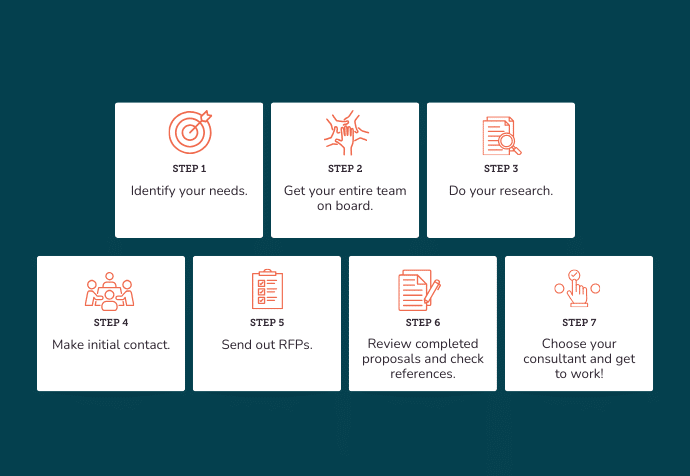
- Identify your needs. Consider exactly what you want to accomplish by working with a marketing consultant. For example, you may need assistance promoting a specific campaign or just want help with your everyday outreach efforts.
- Get your entire team on board. Ensure that everyone on your organization’s team is on the same page about the need for a consultant and what you hope to accomplish by working with them. It will be especially important to have your board’s buy-in from the beginning since you’ll need their approval to spend part of your budget on consulting. Now is the time to also identify how much you’re able to spend and how long you want the consulting engagement to last.
- Do your research. Research your options by conducting Google searches, reading through lists or directories of top providers, and getting recommendations from colleagues in the nonprofit sector. Create a list of potential consultants you’d be interested in working with. Note that every nonprofit marketing firm will have a different specialty or focus. For example, Cornershop Creative specializes in designing easy-to-use and beautiful websites for nonprofits! (Learn more about us below!)
- Make initial contact. Reach out and introduce yourself to each potential consultant to establish a rapport with them. Feel free to ask initial questions about specific services and pricing.
- Send out RFPs. Create a request for proposal (RFP), a document that outlines what you’re looking for in a consulting engagement. This document will give shortlisted candidates the information they need to put together a proposal for your specific project or engagement. Send your RFP to your top candidates and give them a reasonable timetable for turnaround (about two weeks is the standard).
- Review completed proposals and check references. Once you receive completed proposals from your candidates, review them as a team, looking critically at each consultant’s approach and plans. Reach back out to the consultants to ask any clarifying questions or request changes (this is a great way to see how flexible a potential consultant is!). Also, check any references provided by the candidates and ask past clients insightful questions that will help you understand what it’s like to work with a given consultant.
- Choose your consultant and get to work! Once you’ve found the consultant you want to work with, make the engagement official by signing a contract that outlines expectations. Then, you’re ready to get to work!
Looking for a marketing consulting firm that specializes in web design? Cornershop Creative is here to help!
The Role of a Nonprofit Marketing Plan
Rather than diving into marketing headfirst, you’ll want to approach it strategically to see the biggest return on investment (ROI) from your various strategies and develop strong relationships with your community of supporters.
One of the best ways to do this is to create a nonprofit marketing plan. This document lays out your:
- Marketing goals
- Audience information
- Budget
- Core messages
- Chosen marketing channels
- Tools you’ll need to accomplish your marketing goals
In the following sections, we’ll walk you through how you can create your own comprehensive nonprofit marketing plan and walk you through our free marketing plan template!
7 Steps to Create Your Own Nonprofit Marketing Plan
A thoughtful, thorough nonprofit marketing plan can guide your team as it strives to connect with your organization’s supporters and spread the word about the importance of your mission. Follow these steps to create your own:
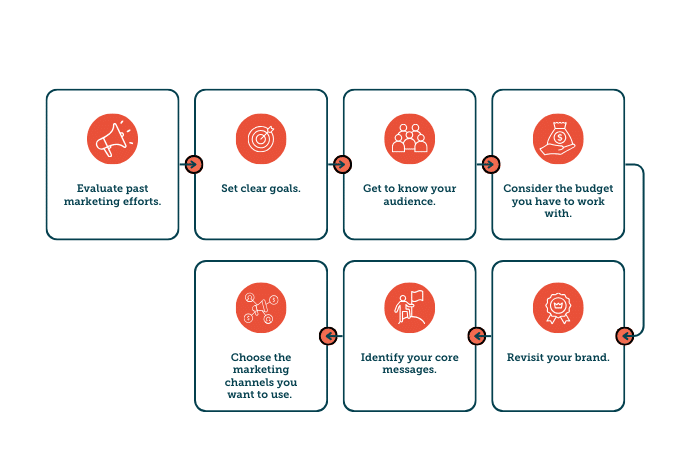
1. Evaluate past marketing efforts.
Before you can think about the future of your marketing strategy, evaluate your past efforts. This will help you identify which supporter engagement efforts have and haven’t worked so far so that your new marketing plan can take your outreach work to the next level.
To apply a critical eye to past marketing work, gather all the data you can on previous campaigns and ask yourself the following questions:
- Did we set specific and measurable goals in the past? Did we reach those goals?
- Were we successful in reaching our target audience? Why or why not?
- Which channels generated the most engagement?
- What was our ROI for each marketing channel we used?
- Did we use clear and consistent messaging throughout the campaign?
- Did we receive feedback from our audience? Did we listen to this feedback and act on it?
- What big-picture lessons can we learn from our past marketing successes and failures?
Remember to focus both on what could be improved and on what worked well in the past. Keeping elements of your strategy that brought you positive results will ensure that you don’t waste time, money, or energy reinventing the wheel when you don’t have to.
2. Set clear goals.
Now that you have a clear picture of your past marketing work, it’s time to set goals for the future. Ensure that your goals are closely tied to your mission and will help your organization drive its community members deeper down the marketing funnel.
One of the best frameworks for setting clear marketing goals is the SMART goal system, in which you outline goals so they are:
- Specific: Marketing goals shouldn’t be too broad, or you may have difficulty tracking progress. For instance, instead of saying you want to “Increase donations,” try something like, “Raise $2500 through our new online donation page by promoting it on our social media profiles and optimizing the page for SEO.”
- Measurable: Measuring your progress toward your goals is essential not just for thorough recordkeeping but also for course-correcting when needed. Ensure that each goal has clear metrics attached to it that you can measure throughout the process. For instance, working off of the example above, you might measure traffic to your online donation page as well as total online donations given in a certain time period.
- Attainable: While you should be ambitious when setting your marketing goals, they should still be milestones you can reasonably achieve. For example, if your organization has only ever raised $2000 on its online donation page, it isn’t likely that you’ll be able to reach a goal amount of $10,000 yet. Set goals that stretch your team but can still be feasibly reached. If you surprise yourself and surpass your goal early, you can always make adjustments.
- Relevant: Each goal should be relevant to your overall mission. For example, the goal to raise $2500 through a new online donation page serves a specific purpose. Digging deeper, that money may help purchase supplies for your animal shelter or fund a month’s worth of programming for your children’s musical theater nonprofit.
- Time-Bound: Deadlines create a sense of urgency in your team members that can motivate them to work hard to help attain your chosen goal. Set a clear deadline for reaching your goal, remembering that you can adjust it if you need to along the way.
Now, let’s put all the pieces together with our example goal:
“Raise $2500 through our new online donation page by March 14. To do this, we will optimize the page for SEO and promote it on our social media profiles. Raising this money will help us purchase needed supplies for our animal shelter to advance our mission of caring for every cat and dog in need in the Houston, Texas area.”
Ensure you write each of your goals out clearly and put them somewhere where you can review them regularly. This will help you stay on track to accomplishing them!
3. Get to know your audience.
Your team can create beautiful fundraising campaigns, write the best email newsletters, or craft thoughtful event reminder text messages, but you’ll only be able to accomplish your marketing goals if these communications resonate with your audience.
You probably already have a good idea of your target audience, especially if your organization is established. But it’s essential to brush up on what you know about your audience to cater your strategies to their needs, expectations, and preferences. This way, you’ll hit your marketing targets more often than not and see the desired results for your mission.
Start by reviewing the data you’ve collected about your supporters in your nonprofit’s database. Look at details such as:
- Demographic information: Age, gender, geographic location, marital status, occupation, interests
- Involvement history: Donation frequency and amount, event participation information, volunteer activities
- Feedback: Survey responses, social media messages or comments, and online reviews
All of this information can help you clearly identify your audience and what helps them engage with your marketing materials and take action for your cause.
For your broader audience, you may find it useful to create an audience persona, a fictitious person who embodies all the traits that make up your “typical” supporter. For example, your audience persona may be a Millennial woman named Rosanna who lives in the Houston, Texas area, donates once a year, volunteers regularly, and provides useful feedback about your organization’s events through surveys. You can picture this fictitious person every time you make a marketing decision to ensure your strategy stays aligned with your audience’s needs.
Note that for supporters who feel more like partners in your work (such as major donors or other key stakeholders), you’ll need to take steps to further personalize your marketing materials to reflect their level of commitment and loyalty. For example, you might know that a major donor enjoys seeing the tangible impact of their donations. For your next donation appeal, you might include some metrics in your letter to the donor that showcase the difference their previous gifts made in order to encourage further support.
4. Consider the budget you have to work with.
The scope of your nonprofit’s marketing strategy will depend largely on the budget you have to work with for your outreach work. Most marketing experts agree that nonprofits should spend between five and 15% of their total operating budget on marketing activities.
Working with your organization’s leadership and board members and keeping past marketing activities and their results in mind, create a marketing budget that best suits your organization. Be sure to factor in any awarded grants that can go toward marketing. It should be enough to help you reach your goals but not so much that it draws support away from other critical areas of your operations. After all, if you spend an exorbitant amount on promoting a volunteer program that you can’t fund, for example, then you may be wishing you had done things differently.
To make your marketing dollar stretch, leverage the following tips:
- Focus on free, organic strategies, such as leveraging SEO for your website or posting on social media channels
- Repurpose and share the same content across different platforms to avoid additional costs
- Apply for the Google Ad Grant to get $10,000/month in free advertising
- Ask loyal supporters to serve as ambassadors for your organization, sharing your messages with their personal networks online and offline
- Use free tools or free versions of tools to create and spread your marketing materials (ex. Canva for graphic design and Mailchimp for creating and sending newsletters to a limited number of subscribers)
5. Revisit your brand.
Your organization’s brand is its unique identity that helps you stand out from other organizations. Though your organization may already have a well-established brand, now is a great time to revisit that brand to ensure it’s communicating what you want it to.
Consider these two core aspects of your brand:
- Non-visual components: Your organization’s tone, personality, values, and approach to its work
- Visual components: Your logo, color scheme, typography, and imagery style
Together, these components make up your organization’s first impression out in the world. Ensure that they’re sending the right message. For example, an organization focused on teaching kids to read might have a casual, fun personality and use a bright color scheme, while another organization that focuses on assisting women and children to heal from domestic violence may take a more somber and professional tone and ensure its visual components match that.
No matter the details, ensure that you create or update a brand book or guide your team can refer to when creating marketing materials. This will help ensure consistency across the board, helping your marketing strategy come across as polished and professional no matter your specific goals.
A well-designed website is the foundation of a great nonprofit marketing plan. Work with Cornershop Creative to design your own!
6. Identify your core messages.
Though your exact wording will change from marketing material to marketing material in each campaign, there are things that you’ll always want to communicate to your audience, no matter the specifics. Outline these core messages for each of your marketing campaigns by doing the following:
- Use your mission and vision as the foundation for all of your marketing work. This will help keep your communications focused and aligned with your cause and big-picture goals.
- Tap into the power of storytelling. Tell your organization’s story, letting your audience see the problems that your beneficiaries are facing and how their support can be instrumental in building a better tomorrow.
- Highlight your impact. Prove to your audience that your organization can achieve what it sets out to do. Use numerical data, success stories, and testimonials to showcase the real-world impact of your work and invite others to be a part of it.
- Keep your messaging simple and clear. Your messages should be easy for anyone to understand. Think of your core messages as “elevator pitches” that quickly explain your organization’s focus and the purpose of each specific project or initiative.
- Incorporate calls to action (CTAs). Calls to action are short statements that invite your audience to do something, whether that means hitting the share button on social media, giving a donation, or registering to volunteer. Always be sure to issue an invitation to act in each marketing message you send.
Consider this example of a core message: Say your nonprofit is launching a capital campaign to renovate its facility, a children’s museum for the disabled community in your area. The core message of your campaign might be, “Help us empower every child by creating a place where all children—regardless of ability—can explore, learn, and grow.” This message might not appear verbatim on all of your marketing materials, but it can guide you in creating them and ensuring that your entire campaign is consistent in what it’s communicating and asking for.
7. Choose the marketing channels you want to use.
There are a variety of marketing channels your nonprofit might use to share its messages with the world. However, you shouldn’t just pick the most convenient or affordable options. Instead, take a thoughtful approach that considers your audience’s needs, your budget, and your level of marketing experience. Doing so will help you create a marketing plan that you can reasonably manage, and that will drive results.
Here are some key channels to consider:
- Your website: A website can serve as the central hub of your organization’s online presence and is a great place to share foundational information about your organization, mission, and team. You can also use your website to drive donations, event registrations, and volunteer sign-ups. To boost your website’s performance, you can engage in search engine optimization (SEO) activities to enhance its visibility on search engines like Google. Learn more about the importance of your website below!
- Fun fact about this marketing channel: Nonprofits get an average of 12,708 website visitors each month.
- Email: Emails are excellent for providing updates on your organization’s work, sharing success stories, and issuing appeals for support. They can include multimedia elements like eye-catching graphics and videos, and they can also link out to other important resources like your website or your social media profiles.
- Fun fact about this marketing channel: Emails with personalized subject lines are 26% more likely to be opened by recipients.
- Social media: If you’re looking for a cost-effective way to spread the word about your organization’s work and connect with supporters on a more individualized level, social media is a great option. Plus, there are a variety of platforms to choose from, each with different styles and requirements. Consider using Facebook, Instagram, X, LinkedIn, TikTok, or a combination of platforms to share your messages in creative ways.
- Fun fact about this marketing channel: Facebook is the most popular social media platform in the world, with 3.06 billion monthly active users.
- Google Ads: If you’ve ever googled something and seen an entry at the top of the results list marked “Sponsored,” you’ve seen a Google Ad. Nonprofits can use Google Ads for free thanks to the Google Ad Grant, which provides them with $10,000 in monthly funding to bid on relevant ad keywords and run their ads. Many organizations like to have an outside consulting firm manage their ads for them to make the most of this opportunity.
- Fun fact about this marketing channel: Google Ad Grants has driven more than 14 billion clicks to nonprofit websites since its creation in 2003.
- Events: Events are a fun way to connect with your supporters, engage in memorable activities, and leave a lasting impression. Though a large event may require some investment upfront, this is a fun way to connect with your supporters, raise funds, and leave a lasting impression.
- Fun fact about this marketing channel: Events provide investments with a 2:1 ROI, meaning it costs 50 cents to raise a dollar through an event.
- Direct mail: There’s a misconception in the nonprofit world that direct mail is an antiquated marketing strategy. In reality, nonprofit supporters today may find that a special note or flyer from your organization stands out in a sea of bills and advertisements!
- Fun fact about this marketing channel: 70% of people agree that direct mail feels more personal than digital marketing materials.
- Text messaging: Texting is an excellent way to reach your community of supporters quickly. Many organizations leverage texting to send out reminders about important events or projects, or even to issue quick donation appeals.
- Fun fact about this marketing channel: The open rate for marketing text messages is a whopping 98%.
- Word-of-Mouth: Word-of-mouth marketing occurs when people share their thoughts about an organization or cause, typically in conversation or via social media. This marketing method can be especially useful to your organization if you already have a community of loyal supporters who are excited to act as ambassadors for your work.
- Fun fact about this marketing channel: 92% of people will believe suggestions from their family or friends rather than advertisements.
In addition to considering the channels that make the most sense for your audience, budget, and experience level, make sure that you plan to use more than one marketing channel in your nonprofit marketing plan. This is called multichannel marketing, and it can help you increase your reach and connect with supporters across a variety of mediums. Keep this familiar saying in mind: “Don’t put all of your eggs in one basket!” Think of multichannel marketing as spreading your marketing efforts around to increase the chances that you’ll see great results.
Our FREE Nonprofit Marketing Plan Template
Now that you know how to create your own nonprofit marketing plan, let’s put all the pieces together in a template that can help guide the process for your organization:
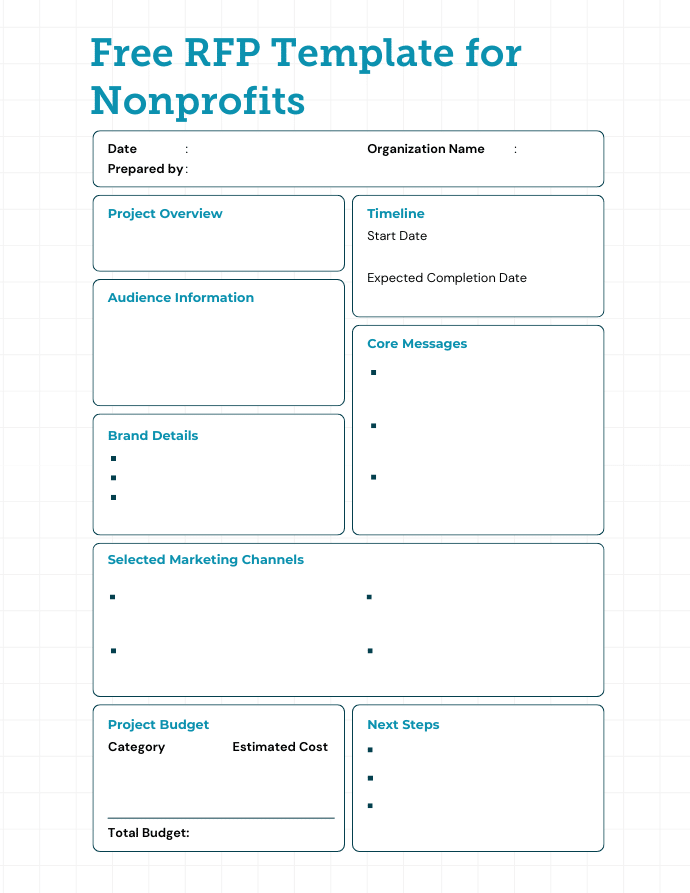
The Role of Your Website in Your Marketing Plan
Did you know that 72% of overall marketing budgets are allocated solely to digital channels? This probably isn’t too surprising, given the ubiquity of the internet in our daily lives. Every day, we have countless opportunities to encounter marketing messages in our email inboxes, text messages, social media feeds, and internet searches.
This is why a website is such a critical part of a nonprofit marketing plan. You can think of your website as your organization’s online headquarters—an online outpost you can direct your audience toward as the source of truth and action for everything related to your nonprofit’s mission.
However, for your website to be a true asset to your marketing strategy, it needs to not only look great but also offer seamless functionality. Otherwise, your audience members will land on it and bounce away.
This is why many organizations invest in working with a nonprofit website design agency like Cornershop Creative!
Why Choose Cornershop Creative?
At Cornershop Creative, we understand that a great website is central to your nonprofit’s marketing success. That’s why we specialize in designing and developing WordPress websites for nonprofits. And we don’t just stop there—we can also help you maintain your website over time, keeping it secure, accessible, and optimized to help you meet your digital marketing goals.
Want to see our design work in action? Check out these recent projects:
Her Justice
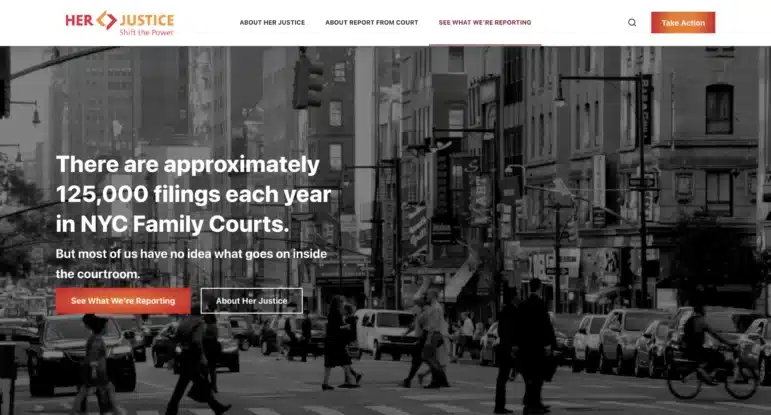
Her Justice is a nonprofit that provides free legal help to women living in poverty in New York City. We teamed up with them to create a visually engaging and information-rich microsite dedicated to court appearance data and experiences. The site supports the organization’s reform efforts.
The END Fund
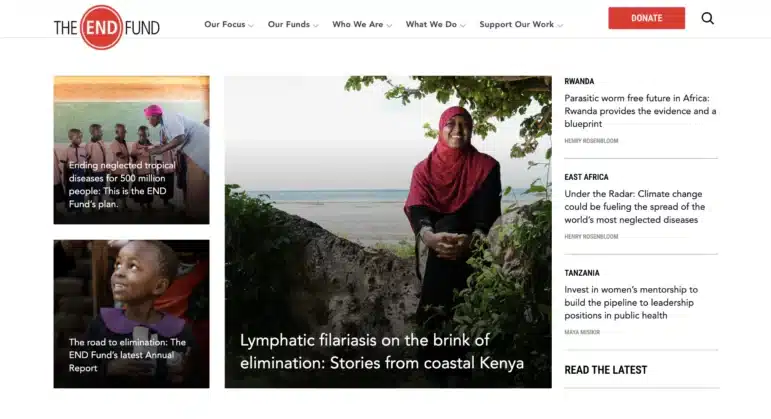
The END Fund‘s mission is to help end neglected tropical diseases. This organization partnered with Cornershop to redesign its existing website to meet its current and future needs. The new site provides clearer information on each of the organization’s funds and is poised to better share information regarding key tropical disease news for the global health community.
Inova

Inova Health Foundation is the fundraising arm of the Inova Foundation, Northern Virginia’s leading nonprofit healthcare provider. We worked with Inova to create a new site that promotes a large upcoming campaign. Now the Inova team can easily update content and highlight their impact.
Interested in going beyond web design? We can also assist your team with constituent relationship management (CRM) and campaign implementation and managing its Google Ad Grant account!
Having an airtight nonprofit marketing strategy is essential for accomplishing your goals and building the relationships that are crucial to your work. Use this guide to design your organization’s own nonprofit marketing plan, and don’t hesitate to reach out to marketing experts (like the Cornershop Creative team!) for assistance!
In the meantime, keep exploring the world of digital marketing and website design with these additional resources and projects:





